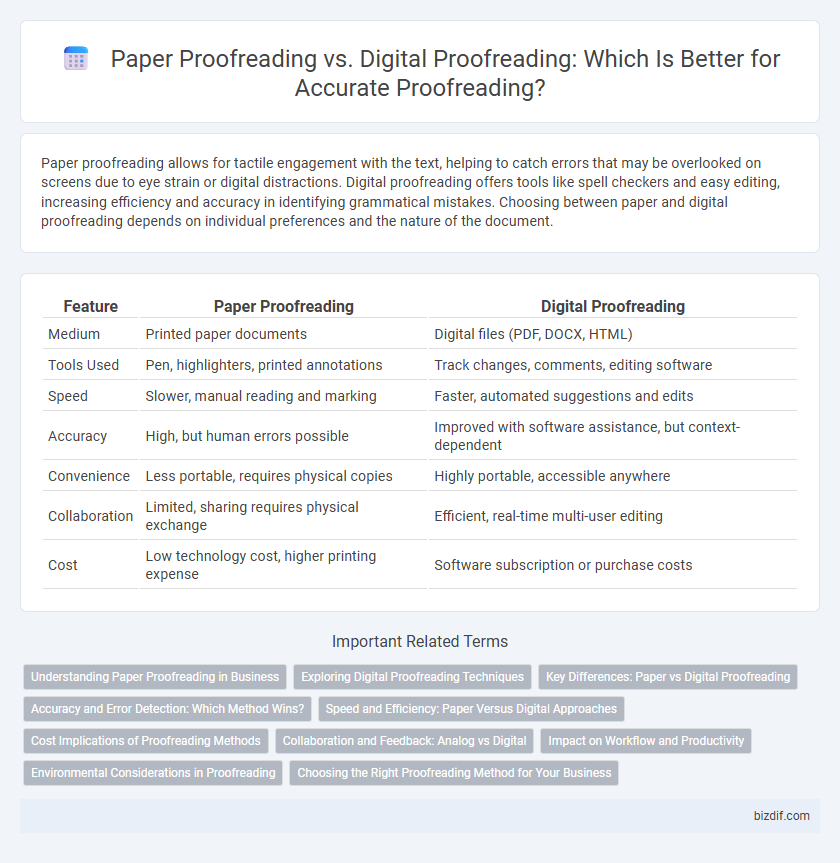Paper proofreading allows for tactile engagement with the text, helping to catch errors that may be overlooked on screens due to eye strain or digital distractions. Digital proofreading offers tools like spell checkers and easy editing, increasing efficiency and accuracy in identifying grammatical mistakes. Choosing between paper and digital proofreading depends on individual preferences and the nature of the document.
Table of Comparison
| Feature | Paper Proofreading | Digital Proofreading |
|---|---|---|
| Medium | Printed paper documents | Digital files (PDF, DOCX, HTML) |
| Tools Used | Pen, highlighters, printed annotations | Track changes, comments, editing software |
| Speed | Slower, manual reading and marking | Faster, automated suggestions and edits |
| Accuracy | High, but human errors possible | Improved with software assistance, but context-dependent |
| Convenience | Less portable, requires physical copies | Highly portable, accessible anywhere |
| Collaboration | Limited, sharing requires physical exchange | Efficient, real-time multi-user editing |
| Cost | Low technology cost, higher printing expense | Software subscription or purchase costs |
Understanding Paper Proofreading in Business
Paper proofreading in business involves carefully reviewing physical printed documents to identify errors in grammar, punctuation, and formatting, ensuring accuracy before final distribution. This method enables proofreaders to detect subtle mistakes that may be overlooked on digital screens, such as paper quality issues or ink smudges affecting legibility. Emphasizing tactile engagement, paper proofreading enhances attention to detail, crucial for producing professional business materials like contracts, reports, and marketing collateral.
Exploring Digital Proofreading Techniques
Digital proofreading techniques enhance accuracy by leveraging tools like AI-powered grammar checkers, automated style guides, and real-time collaborative platforms. These technologies enable efficient error detection, consistency verification, and version tracking, surpassing traditional paper proofreading limitations. Incorporating digital methods streamlines the revision process, reduces human oversight, and supports multilingual content accuracy.
Key Differences: Paper vs Digital Proofreading
Paper proofreading allows annotators to engage with physical documents, facilitating direct interaction with printed text and traditional marking tools to highlight errors. Digital proofreading offers enhanced efficiency through features like track changes, automated spell check, and easy collaboration across devices, streamlining error correction processes. Key differences include the tactile experience and slower pace of paper proofreading versus the speed, convenience, and advanced editing capabilities inherent to digital proofreading platforms.
Accuracy and Error Detection: Which Method Wins?
Paper proofreading delivers superior accuracy by allowing proofreaders to physically mark errors, enhancing focus and reducing oversight risk. Digital proofreading leverages advanced software tools and automated error detection algorithms, rapidly identifying spelling, grammar, and formatting mistakes. Combining both methods often ensures the highest error detection rates and overall text precision.
Speed and Efficiency: Paper Versus Digital Approaches
Digital proofreading significantly enhances speed and efficiency by enabling instant text searches, automated error detection, and seamless document editing, reducing the time spent on manual corrections. Paper proofreading demands slower, meticulous reading and physical markup, which increases the time investment and limits quick revisions. Consequently, digital approaches streamline the proofreading process, improving productivity and accuracy in content refinement.
Cost Implications of Proofreading Methods
Paper proofreading typically incurs higher costs due to expenses related to printing, physical distribution, and manual labor for corrections. Digital proofreading reduces these costs by enabling instant edits, easy file sharing, and automated tools that minimize human error and time investment. Enterprises often favor digital methods to support cost-efficiency and faster turnaround times in document review processes.
Collaboration and Feedback: Analog vs Digital
Paper proofreading facilitates tactile collaboration, allowing multiple reviewers to mark up physical copies with handwritten notes and annotations, fostering immediate, personal feedback. Digital proofreading enables real-time collaboration through cloud-based platforms, supporting simultaneous edits, version control, and instant comment exchanges for efficient communication. The contrast lies in paper's tangible, slower feedback loop versus digital's dynamic, streamlined interaction enhancing productivity.
Impact on Workflow and Productivity
Paper proofreading involves reviewing hard copies, which can slow down workflow due to manual marking and slower revision cycles, reducing overall productivity. Digital proofreading leverages tools like automated spell-checkers and collaborative platforms, streamlining error detection and enabling faster, real-time updates. Integrating digital proofreading increases workflow efficiency and accelerates turnaround times, significantly boosting productivity in document review processes.
Environmental Considerations in Proofreading
Paper proofreading generates significant paper waste and consumes more physical resources, contributing to environmental degradation. Digital proofreading reduces paper consumption and carbon footprint by utilizing electronic documents and cloud-based tools. Emphasizing sustainable practices, digital proofreading supports eco-friendly workflows and minimizes deforestation and landfill burden.
Choosing the Right Proofreading Method for Your Business
Paper proofreading ensures meticulous review of physical documents, ideal for businesses handling legal contracts or printed marketing materials that require exact accuracy. Digital proofreading leverages software tools and collaboration platforms, offering efficiency and real-time editing suitable for companies with fast-paced content production and remote teams. Selecting the right method depends on factors like document type, workflow speed, and the need for accuracy versus flexibility in your business operations.
Paper proofreading vs Digital proofreading Infographic

 bizdif.com
bizdif.com